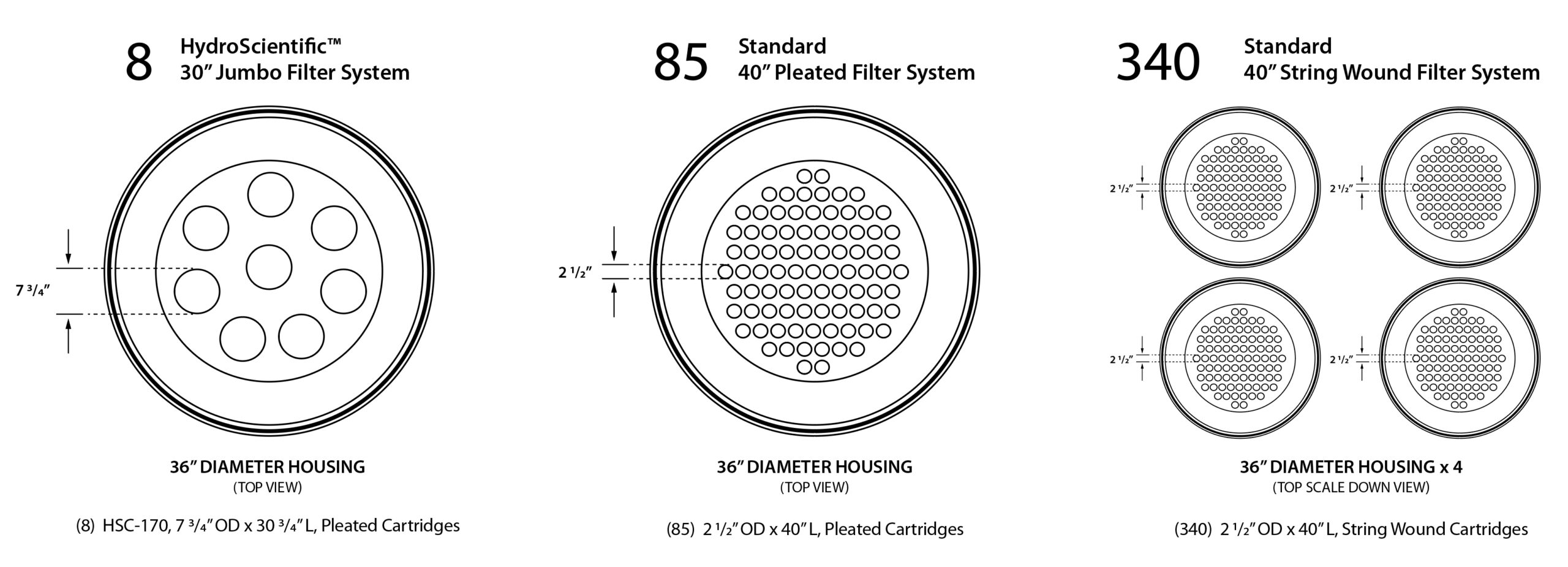HydroScientific™
Housing and Cartridge Selection Guide
SELECTING FILTER HOUSINGS AND CARTRIDGES THAT ARE CORRECT FOR YOUR APPLICATION IS IMPERATIVE FOR A SOUND FILTRATION PROCESS TO OCCUR
1. Filter Cartridge Selection
DETERMINE THE NATURE OF THE CONTAMINANT
First determine exactly what you want the filter to remove and whether the material is hard, gelatinous or fibrous. This is very important because some filters work better than others for each contaminant type. For example, you wouldn’t want to use a screen filter to remove a gel because the gel, under pressure, would break apart or pass through the screen.
DEGREE OF FILTRATION REQUIRED
As a general rule of thumb, the finer the filter the more it costs. Therefore, the most economical filter selection is accomplished by determining exactly what removal rating is required to do your filtration. In cases where the filters are protecting an operation or piece of equipment, this can be easily accomplished. However, in applications where filtration is used to refine a product, testing a variety of media is the best method for this determination.
COMPATIBILITY OF THE FILTER ELEMENT
Be certain to consider operating temperature, pressure and application in this determination.
Overall cost of operation. Include labor and cost of disposal in this calculation. Sometimes the filter element that may cost a little more to purchase may be easier to dispose of or lasts longer. As an example, one single HSC-170 Series Jumbo cartridge is equal to 43 standard 9-3/4” pleated cartridges. The Hurricane® cartridges cost more to buy, but cost less to use, resulting in lower operating cost.
Overall cost of operation. Include labor and cost of disposal in this calculation. Sometimes the filter element that may cost a little more to purchase may be easier to dispose of or lasts longer. As an example, one single HSC-170 Series Jumbo cartridge is equal to 43 standard 9-3/4” pleated cartridges. The Hurricane® cartridges cost more to buy, but cost less to use, resulting in lower operating cost.
2. Filter Housing Selection
FILTER HOUSING MATERIALS
Filter housing materials must be compatible with the process in which it is being used. Be sure to include operating temperature, pressure and regulatory requirements imposed by local, State and Federal agencies.
FILTER HOUSING SIZING
Flow requirements, solids loading, viscosity of the material being filtered, and pressure drop requirements will determine the number (or size) of cartridges (surface area) needed and thus the size of the filter housing. Always oversize your filter housing by 25-30% allowing for future growth and efficiency.
3. Surface Area Comparison
When filtering sediment, sand or any other contaminant where “filter cake” can build on the cartridge material, Jumbo filter cartridge elements will likely offer the lowest cost per filtered gallon. This is based on run time and pressure drop and efficiency.
The following compares HydroScientific Jumbo HSC Series cartridge elements against multi-round standard housings with 2-1/2” diameter cartridges. This comparison is based on 1,360 sq. ft. of media (surface area) at 840 gpm with a flow (flux) rate of 0.6176 gpm per sq. ft. of media.
The following compares HydroScientific Jumbo HSC Series cartridge elements against multi-round standard housings with 2-1/2” diameter cartridges. This comparison is based on 1,360 sq. ft. of media (surface area) at 840 gpm with a flow (flux) rate of 0.6176 gpm per sq. ft. of media.


